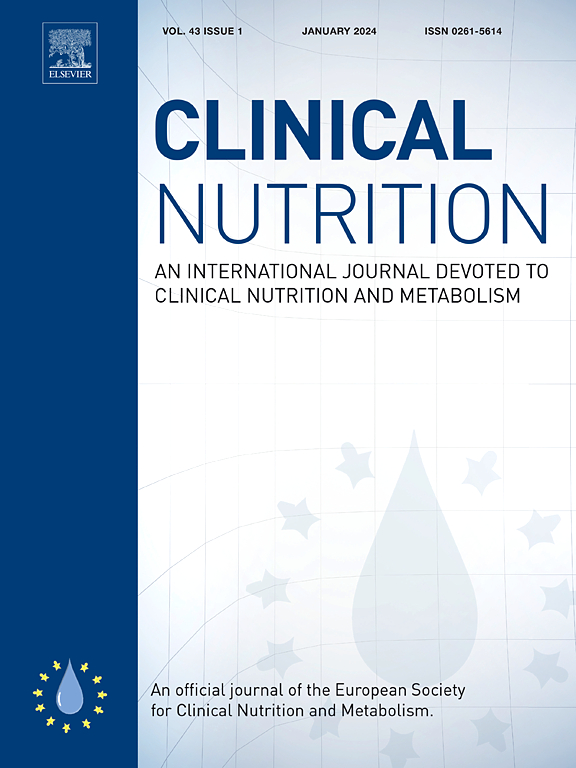血脂与全因死亡率和特定原因死亡率之间关系的系统分析:来自英国生物银行和妇女健康倡议前瞻性队列研究的证据
IF 6.6
2区 医学
Q1 NUTRITION & DIETETICS
引用次数: 0
摘要
背景,目的血脂,包括脂蛋白、胆固醇和甘油三酯,是影响人类健康的重要可调节因素。然而,不同血脂谱与死亡率之间的关系仍然没有得到充分的了解,特别是关于潜在的因果关系和人群异质性。本前瞻性研究旨在系统地探讨不同密度和大小的血脂浓度与全因死亡率和病因特异性死亡率之间的关系。方法采用scox比例和Fine-Gray亚分布风险模型,对441,448名英国生物银行队列患者进行17年随访,研究54种脂质浓度与全因和病因特异性死亡率(包括心血管疾病(CVD)、癌症和呼吸系统疾病)的关系。来自妇女健康倡议(WHI)的120,967和44,168人的队列进行了16年的随访和大规模荟萃分析,用于外部复制。我们使用孟德尔随机化(MR)进一步评估了潜在的因果关系,并使用多亚组分析评估了可能的修正因素。结果在中位13.8年的随访期间,发生39,290例死亡,其中心血管疾病7399例,癌症18,928例,呼吸系统疾病2707例。我们确定了160个脂质浓度与全因死亡率和病因特异性死亡率之间的显著关联。重要的是,大多数是相反的,脂质水平降低与过早死亡风险增加有关[风险比(hr): 0.70-0.98 /标准差(SD)]。相反,高密度脂蛋白(高/非常高)和甘油三酯浓度呈阳性[hr: 1.02-1.25 / SD],表明较高的水平会增加死亡风险。大多数脂蛋白和胆固醇与死亡率呈非线性相关,特别是总脂蛋白/高密度脂蛋白呈显著的u型关系。然而,磁共振显示几种脂质的升高与全因和cvd特异性死亡风险增加有关。多亚组分析显示,年龄、性别和降脂药物改变了血脂与死亡率的关系;具体来说,较高的脂质浓度增加了未服用降脂药物的年轻人的死亡率,但降低了服用降脂药物的老年人的死亡率。大多数关联在WHI和外部队列中得到了重复。结论本研究系统地报道了大量血脂浓度与死亡率之间的关联。基于亚组的人群异质性分析表明,年龄、性别和脂质调节药物可能是脂质-死亡率关系的调节因素。这些发现为脂质管理和个体化预防提供了更多的指导。本文章由计算机程序翻译,如有差异,请以英文原文为准。
Systematic analysis of relationships between serum lipids with all-cause and cause-specific mortality: Evidence from prospective cohort studies of UK Biobank and Women's Health Initiative
Background & aims
Serum lipids, including lipoproteins, cholesterol, and triglycerides, are important modifiable factors influencing human health. However, the associations among different serum lipid profiles and mortality remain insufficiently understood, particularly regarding potential causality and population heterogeneity. This prospective study aims to systematically investigate the relationships between serum lipid concentrations of different densities and sizes with all-cause and cause-specific mortality.
Methods
Cox proportional and Fine–Gray subdistribution hazard models were applied to investigate the associations of 54 lipid concentrations with all-cause and cause-specific mortality (including cardiovascular disease (CVD), cancer, and respiratory disease) in the UK Biobank cohort of 441,448 individuals with 17-year follow-up. Cohorts of 120,967 and 44,168 individuals from the Women's Health Initiative (WHI) with 16-year follow-up and a large-scale meta-analysis were utilized for external replication. We further assessed the underlying causality using Mendelian randomization (MR) and possible modifiers using multiple subgroup analyses.
Results
During a median follow-up of 13.8 years, 39,290 deaths occurred, including 7399 from CVD, 18,928 from cancer, and 2707 from respiratory disease. We identified 160 significant associations between lipid concentrations and all-cause and cause-specific mortality. Importantly, most were inverse, with decreased lipid levels linked to increased risk of premature death [hazard ratios (HRs): 0.70–0.98 per standard deviation (SD)]. In contrast, positives were observed for HDL (large/very large) and triglyceride concentrations [HRs: 1.02–1.25 per SD], indicating increased mortality risk with higher levels. Most lipoproteins and cholesterol exhibited nonlinearly correlations with mortality, especially the significant U-shaped in total/HDL. However, MR showed that elevations in several lipids were associated with increased all-cause and CVD-specific mortality risk. Multiple subgroup analyses revealed that age, sex, and lipid-modifying drugs modified the lipid-mortality relationship; specifically, higher lipid concentrations increased mortality risk in younger adults not taking lipid-modifying drugs, but decreased mortality in older adults taking lipid-modifying drugs. The majority of associations were replicated in the WHI and external cohorts.
Conclusion
Our study systematically reported a large number of associations between serum lipid concentrations and mortality. Subgroup-based population heterogeneity analysis suggests that age, sex, and lipid-modifying drugs could be modifiers for the lipid-mortality relationship. These findings provide more guidance for lipid management and individualized prevention.
求助全文
通过发布文献求助,成功后即可免费获取论文全文。
去求助
来源期刊

Clinical nutrition
医学-营养学
CiteScore
14.10
自引率
6.30%
发文量
356
审稿时长
28 days
期刊介绍:
Clinical Nutrition, the official journal of ESPEN, The European Society for Clinical Nutrition and Metabolism, is an international journal providing essential scientific information on nutritional and metabolic care and the relationship between nutrition and disease both in the setting of basic science and clinical practice. Published bi-monthly, each issue combines original articles and reviews providing an invaluable reference for any specialist concerned with these fields.
 求助内容:
求助内容: 应助结果提醒方式:
应助结果提醒方式:


